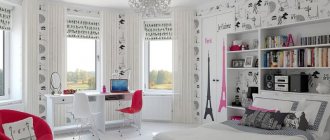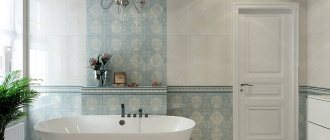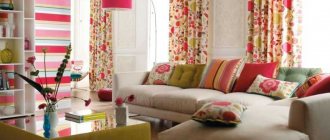How to make a room cozy with your own hands - photo
Elements that embody coziness and comfort help make the “right” interior warm and homely. You are familiar with them, but in order for these details to “work” for comfort and not create chaos in the house, they need to be used correctly.
Chaotically scattered anywhere, not coordinated in color with other interior elements, pillows will not decorate, but rather clutter your home. Beautiful, but too hard pillows will make you and your guests want only to remove them when you sit down to rest, so:
- Choose soft, voluminous pillows: down, synthetic padding, or holofiber. The most environmentally friendly options for fillers are bamboo fiber and buckwheat husks.
- Pillows can be laid out not only on the sofa, but also on armchairs and on the floor.
- The color of the pillows should be repeated in other things that are in the room (curtains, carpet, wallpaper, lamps, flower pots, etc.).
Depending on the season, pillows (or their covers) can be changed in autumn and winter, using knitted and woolen ones in warm, soothing shades, and in spring and summer – silk and cotton ones in rich, rich colors.
Color palette
Cozy colors are different for everyone. Some people agree with dark walls (they really create a chamber atmosphere), others with brown furniture and beige wallpaper. But when choosing a palette, you should remember the location of the apartment: on the north side, where the sun rarely peeks, cold shades (blue, blue, emerald and gray) will not bring coziness to the room, but will make it even more faded. Warm colors - yellow, pink, orange - will improve your mood and add vigor.
In a small apartment, it is better to choose light shades for the walls, as bright colors can make the space look smaller and can be added as accents. One of the most win-win options for walls is white. It serves as a great backdrop for contrasting furniture and allows you to experiment with textiles that can be changed depending on your mood or season. In addition, white optically expands the space by reflecting light.
How to make a small room cozy and beautiful
Functional layout and comfortable placement of furniture are necessary to create comfort, especially in small rooms. Modern modular shelving, horizontal and vertical shelves, sofas, chairs and coffee tables can visually enlarge small spaces.
Soft fabrics, soothing and elegant patterns, stylish fabrics and embellishment accessories handmade with embroidery or appliqué, crochet and knitwear bring a cozy feel to a small room design and create a stylish yet relaxing and tranquil atmosphere.
A blanket as a decorative element is very “movable”: it can travel from room to room on your shoulders, “move” from a sofa to an armchair, from an armchair to a bed, and from there to the floor. But, no matter where the blanket is, it will add coziness to the room.
The most comfortable blankets are cashmere, wool with the addition of artificial fibers (in this case, the product does not itch), cotton, knitted (especially large knit), and also those in “Scottish check” colors.
If you are not using the blanket at the moment, do not put it away, but carefully fold it and throw it over the armrest of the sofa or the back of the chair: the mere presence of this element will warm the room.
Checkered and colorful blankets look good against the backdrop of furniture and other interior items of calm, solid colors.
How to make your dorm room more comfortable
If you want the comfort of a dorm room, choose upholstered furniture with textile upholstery, and decorate the windows with fabric curtains.
Excellent creators of comfort - tablecloths, bedspreads, handmade textile elements. They will soften and “domesticate” even the most austere interior.
Curtains and other textile elements can either transform a room or ruin its appearance, so take the choice of colors and textures seriously.
Avoid excessive variegation: the checkered upholstery of the chair, the variegated bedspread on the sofa and the flowered curtains will “quarrel” with each other.
Bright and colorful elements look good against the background of plain wallpaper and furniture (especially pastel shades).
Cover the table with two or three tablecloths of different lengths, one peeking out from under the other, and the dorm room will become more comfortable.
How to make a children's room cozy
To make a child's room cozy, look for white, airy decor with bright details to add warmth and color.
Children's toys and accessories for interior decoration create a beautiful and cozy interior for a child's room.
The creamy white and light yellow shades of natural wood and the dark gray or brown colors are very attractive and beautiful.
Decorative fabrics, wallpaper or vinyl wall decals, wall art ideas and furniture enhance the interior style and make the kids room design look pleasant, cozy and relaxing.
Convenient storage containers, baskets and shelves made from natural materials can help organize decor and keep your child's bedroom clean and tidy.
Preschooler's corner
The preschooler's place is characterized by a playful orientation. His personal space should correspond to his hobbies, character and interests; it should be bright, colorful, functional and safe.
The preschooler's children's area should include places for storing toys, playing games and developing activities.
Sports section
To ensure the physical activity of a growing child, it is advisable to purchase a sports corner. You can easily organize it yourself. Swings, horizontal bars, rope ladder, gymnastic rings, wall bars - all these are constant attributes of a sports playground in a spacious apartment or house.
A sports facility can be either in the form of a whole complex or in the form of a separate attribute.
Game corner
The main type of activity of a preschooler is play activity. Therefore, when designing the baby’s area, it is necessary to pay special attention to the area that is intended for games and entertainment.
Corner for two
For small one-room apartments, the ideal solution for arranging a children's corner would be a loft bed. This multifunctional bed is both a sleeping place and a play area that can be designed according to the interests and age of the child. If there are two children, the lower tier can be turned into a play area during the day and used as a sleeping place at night.
A bunk bed is also a great solution if you have two children. The lower tier can be used for both games and activities.
Tip: To optimize space, you can use shared tables with stands, whiteboards or art kits on the wall.
Children will love such a table, even if they have different interests - for example, if one is interested in drawing, and the other likes to sculpt from plasticine. Shelves on the walls will help save space and keep things organized and clean.
For schoolchildren
The main activity of a schoolchild is academic. Consequently, the zone is formed to provide the most comfortable space for doing homework. The student should have a comfortable table, shelves or cabinets where he can put away textbooks and notebooks after classes.
When designing a corner for a schoolchild, it is best to allocate a part for his hobbies: musical, sports, creative, etc.











